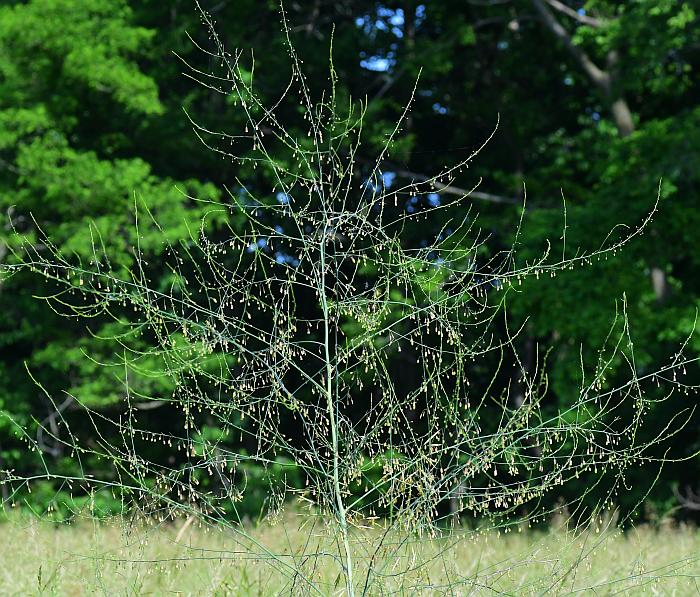Asparagus officinalis L.
Asparagus

Introduced
CC = *
CW = 3
MOC = 40
© SRTurner
Asparagus officinalis L.Asparagus | |
 |
Introduced CC = * CW = 3 MOC = 40 |
© SRTurner |
|
Family - Liliaceae Habit - Rhizomatous, dioecious, perennial forb. Stems - Spreading to erect, to 2 m, herbaceous, much branched, glabrous, green. Upper branch segments linear, to 2.5 cm long, 0.5 mm broad, in groups of 1-5 per node, glabrous, sometimes appearing fascicled like pine needles.
Leaves - True leaves very small, alternate, reduced to triangular scales on main stem, glabrous.
Inflorescence - Single or paired flowers from nodes of aerial stems. Pedicels jointed above the middle, 8-15 m long, glabrous. Flowers - Perianth 3-6 mm long, that of the pistillate flowers slightly shorter than that of the staminate flowers, bell-shaped, the tepals oblong-elliptic, fused at the base, rounded at apex, greenish white to greenish yellow, glabrous. Stamens 6, fused to the base of the perianth, not exserted. Filaments to 3 mm long, glabrous. Anthers orange. Style 1, with 3 short stigmas. Ovary superior, 1.8 mm long, with 3 locules, each with 2 ovules.
Fruits - Berries 8-10 mm long, globose, orange-red at maturity, glabrous, with 3-6 seeds.
Flowering - May - June. Habitat - Pastures, fencerows, fields, old homesites, disturbed sites, open woods, roadsides, railroads. Origin - Native to Europe. Lookalikes - None. Other info. - This plant is found sporadically throughout most of Missouri and the continental U.S. It is easy to recognize from its large habit and frilly "leaves" which are actually highly divided stems. The flowers are small and relatively inconspicuous. Pistillate plants are more noticeable late in the season, with round red berries contrasting with the green plants. Photographs taken at the Martha LaFite Thompson Nature Sanctuary, Clay County, MO., 5-12-00 (DETenaglia); also at St. Joe State Park, St. Francois County, MO, 5-21-2020, and near Labadie, Franklin County, MO, 5-31-2020, 9-4-2020, and 7-9-2021 (SRTurner). |